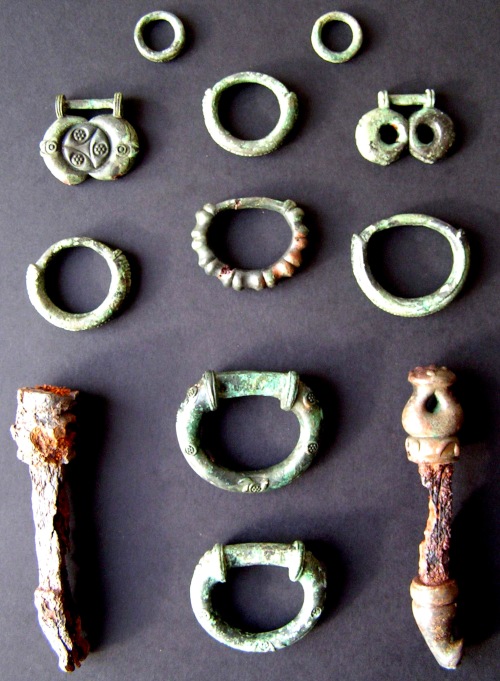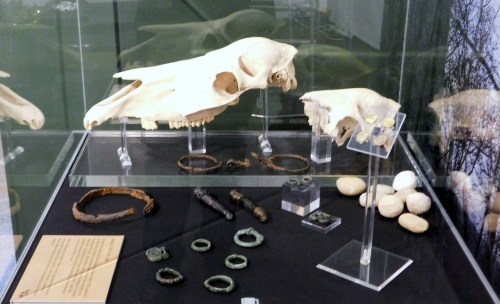
Bury Hill viewed from the west. The early fort touches the left hand side of the image, the later fort is dead centre. The ‘annexe’ occupies the harvested field to the right.
Bury Hill’s earthworks are quite prominent on the summit of a low rise at the confluence of the rivers Anna and Anton, near Andover. An Early Iron Age hillfort of 10 ha (24 acres) occupies the site but was superseded by a much stronger circular fort of half the size. The earlier enclosure, tested by geophysical survey and excavation, had no evidence of occupation, but it was a different picture in the later camp, which was densely packed with features.
What was striking about Barry Cunliffe’s work here in 1990 was the remarkable haul of horse harness and chariot fittings. The excavation produced six copper alloy terret rings, three strap unions, two small strap rings, a linchpin and an antler side piece capped with a copper alloy disc, as well as numerous iron horse bits and nave rings. Actual horse remains comprised 48% of the animal bones found, about ten times higher than at nearby Iron Age sites, suggesting highly specialised activity at Bury Hill.

A selection of the Bury Hill harness and chariot fittings.
Calculations show an average height of eleven hands for a horse population aged between one and fourteen years. With less than 5% juvenile mortality it is likely that the animals were not kept for breeding and they may have been semi-feral, similar to New Forest ponies today. With peak mortality at age six or seven years it is also unlikely that they were exploited for meat. The probability is that the herd was carefully managed, with the emphasis on horses for riding and chariot use.
It seems clear that the community viewed the chariot as a symbol of prestige. It is likely that the vehicles were manufactured at the site and the necessary specialised metalwork made there by craftsmen working for the local elite. This was a group potentially more warrior-dominated than in previous Iron Age generations and ties in with Caesar’s descriptions from 54 BC, when the Late Iron Age forces ranged against him included up to 4,000 chariots!

Chariots in the heat of Late Iron Age battle – from a painting by Mike Codd.
The Wessex Hillforts Survey has identified an oval enclosure of approximately 1.6ha (4 acres) just outside the later camp at Bury Hill, with its largest entrance facing towards the fort. Is this where the elite warriors – the royal house guard or comitates – strutted their stuff, leaving the artisans to their carpentry workshops and smithies inside the defences?

The archaeological evidence: horse bones, nave rings and linch pins from chariot axles, and a variety of horse bits, terret rings and strap unions from the harness; plus a cluster of sling stones. In the Royal Blood exhibit at Andover Museum until 10 July, 2016.
The allegiance of this Late Iron Age ‘arms factory’ is not clear. The local Atrebates tribe were pro-Roman, but suffered incursions from the Trinovantes and Catuvellauni. Whoever it was they followed, there’s no doubt that the later 1st century BC and the early 1st century AD were turbulent times, if the importance given to the production of weapons of war is anything to go by.
Royal Blood Postscript: In later times Polydore Vergil (16th century) and Sir Richard Colt Hoare imagined Edmund Ironside and the Danish King Canute occupying Bury Hill and Balksbury respectively, as they slogged it out for possession of England in the early 11th century, but there is no hard evidence for this episode from either site.
Reference:
Cunliffe, B & Poole, C. 2000. The Danebury Environs Programme: The Prehistory of a Wessex Landscape Vol 2, part 2. Bury Hill, Upper Clatford, Hants, 1990. English Heritage and Oxford University Committee for Archaeology Monograph no. 49.
Series by: Dave Allen, Sarah Gould, Jane King, Lesley Johnson, Peter Stone





